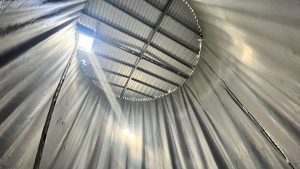
At ATM Tanks, we specialise in providing top-of-the-line reinforced PVC tank liners that are designed to withstand even the toughest conditions. Here’s why our liners are superior to the competition and more durable and long-lasting than other liners on the market:
What Are Reinforced PVC Tank Liners?
Reinforced PVC tank liners are a type of liner that is designed to provide a protective layer inside tanks to prevent leaks and corrosion. These liners are made from high-quality PVC material that is reinforced with polyester fabric to improve their strength and durability.
What Makes Our Reinforced PVC Tank Liners Superior?
At ATM Tanks, we use only the highest quality materials to create our reinforced PVC tank liners. We use a specialised PVC material that is specifically formulated for long-term durability in harsh environments. This material is resistant to Ultra Violet rays, harsh chemicals, and possible punctures, making it a reliable choice for even the most demanding applications.
Our reinforced PVC tank liners are also designed to be custom fit to ensure a perfect fit for your water tanks. Our liners can be made to fit any size or shape, meaning you won’t have to worry about gaps or overlaps that could compromise the integrity of your liner. We use state-of-the-art technology to create precise measurements and ensure a perfect fit every time.
Our reinforced PVC tank liners are also incredibly easy to install. Our team of experts will work with you to determine the best installation method for your specific needs, whether that involves welding or adhesive bonding. Once we’ve determined the best approach, we’ll handle the entire liner installation process from start to finish, ensuring a seamless and hassle-free experience for you.
Why Are Our Reinforced PVC Tank Liners More Durable and Long-Lasting?
Perhaps the most important factor when it comes to selecting a tank liner is durability. After all, you need a liner that can stand up to the elements and protect your property for years to come. When you choose an ATM Tanks reinforced PVC tank liner, you can rest assured that you’re getting a product that is built to last.
Our reinforced PVC tank liners are incredibly durable and long-lasting for several reasons. First and foremost, our liners are made from high-quality materials that are designed to withstand even the toughest conditions. The PVC material we use is resistant to damage from UV rays, chemicals, and punctures, meaning you won’t have to worry about costly repairs or replacements down the line.
Additionally, our reinforced PVC tank liners are designed with a polyester fabric reinforcement that improves their strength and durability. This reinforcement layer helps to prevent tears and punctures, ensuring that your liner will last for years to come.
Our reinforced PVC tank liners are also incredibly resistant to corrosion, which is a major concern for many industries. Our liners are specifically designed to prevent corrosion and rust from damaging your tanks, ensuring that your investment is protected for the long haul.
Finally, our reinforced PVC tank liners are incredibly easy to maintain. They require minimal upkeep and can be easily cleaned with soap and water. This means that you won’t have to spend time and money on expensive maintenance or cleaning products, allowing you to focus on running your business.
Customer Service
At ATM Tanks, we pride ourselves on providing exceptional customer service to our clients. Our team of experts is always on hand to answer any questions you may have and provide guidance throughout the entire process. We understand that every project is unique, which is why we work closely with our clients to ensure that we’re meeting their specific needs and requirements.
In conclusion, if you’re in need of a high-quality reinforced PVC tank liner for your industrial or commercial property, look no further than ATM Tanks. Our liners are designed with durability, customisability, and ease of installation in mind
- Choosing the Best Tank Liners for Longevity - December 7, 2025
- Pro Solutions for Effective Industrial Tank Cleaning - December 7, 2025
- What to Do When Your Tank’s Waterproofing Fails - December 7, 2025







